Easy High-Heat Roast Turkey with Gravy
This post may contain affiliate links. Read my full disclosure policy.
Ideal for turkeys under 14 pounds, the high-heat method guarantees a juicy and crisp-skinned turkey.
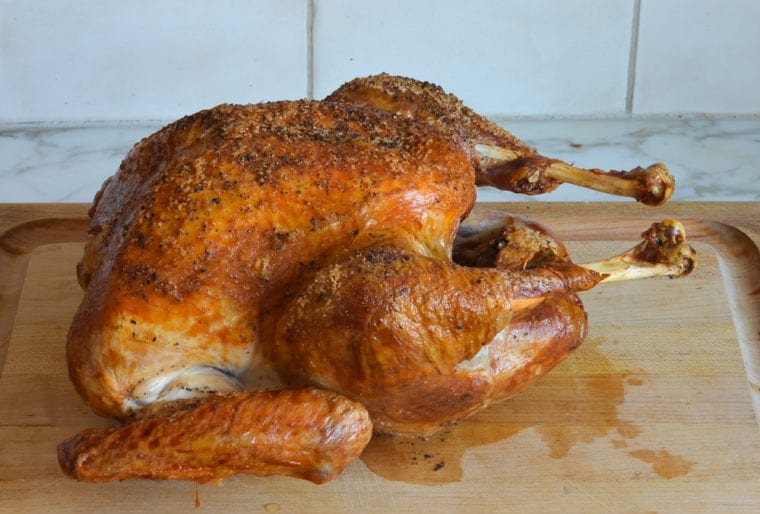
The high-heat roasting method is one of my favorite ways to cook a turkey. The prep time is minimal, the cooking time is short, and the turkey emerges from the oven juicy and crisp-skinned. The only drawback is that the high heat can cause a little smoke in the kitchen, so be sure your oven is spotless prior to cooking — and while the bird roasts, turn on your exhaust fan and crack a window. This cooking method only works for turkeys under 14 pounds. For larger birds, I recommend this dry-brined turkey recipe.
For Thanksgiving, I typically make one roast turkey along with a rolled stuffed turkey breast (a make-ahead family favorite) so we have variety and plenty of leftovers. Finally, if you’re a turkey novice or cooking a turkey feels intimidating, check out my best turkey advice; it will make you feel better!
What you’ll need to make roast turkey with Gravy
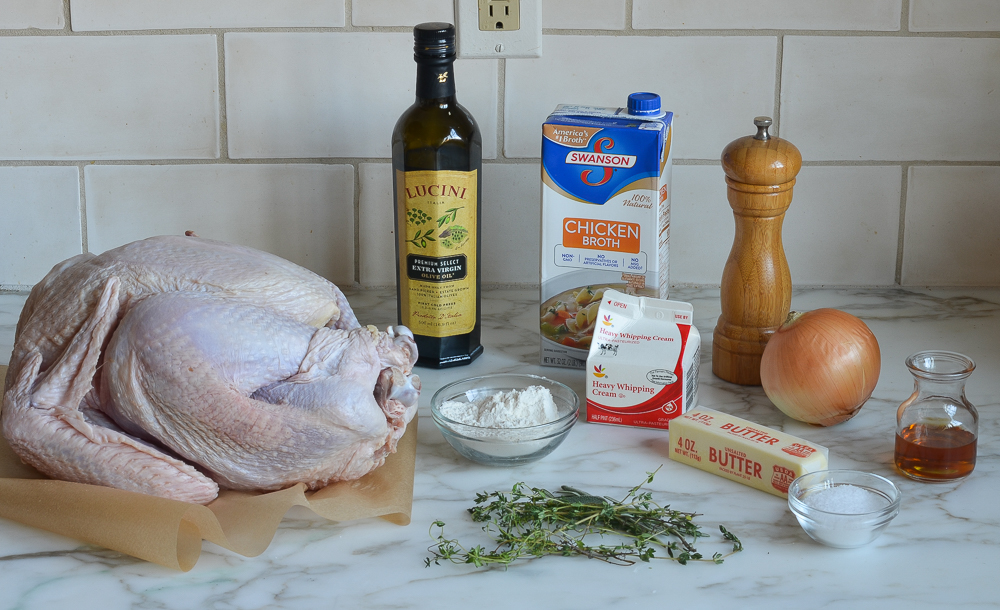
How to make roast turkey with Gravy
To begin, remove and discard truss that holds turkey legs together. Trim off and discard any excess fat in the neck or body cavity. Remove giblets and neck; discard or save for stock.
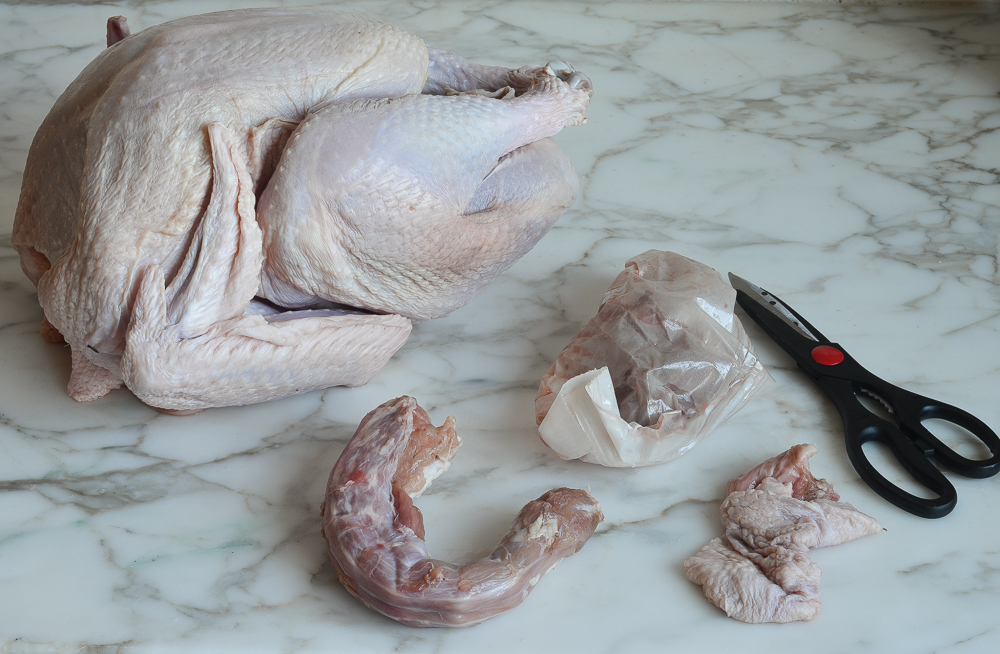
Rinse turkey inside and out with warm water. Pat dry with paper towels. Place a V-shaped rack in a 13 x 16 x 3-inch heavy stainless-steel roasting pan. (Do not use a dark roasting pan or a disposable aluminum pan.)
Rub the turkey skin all over with the olive oil and sprinkle with the salt and pepper. Set the bird breast-side-up on the rack. Pull the wings away from the body, then firmly twist them to push the wing tips under the bird.
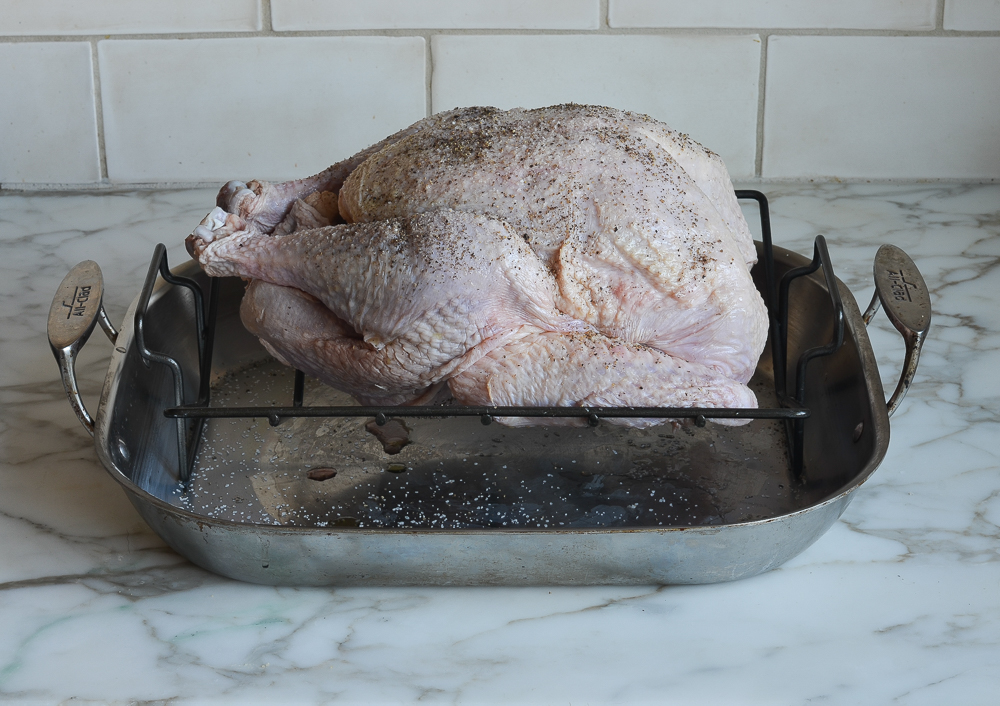
Using aluminum foil, form caps over the tips of the end of each drumstick. (Do not tie the legs together, add stuffing, or close the body cavity.) Insert a digital leave-in meat thermometer near the center of the breast through thickest part until the tip touches the bone. Turn on your exhaust fan and crack a kitchen window.
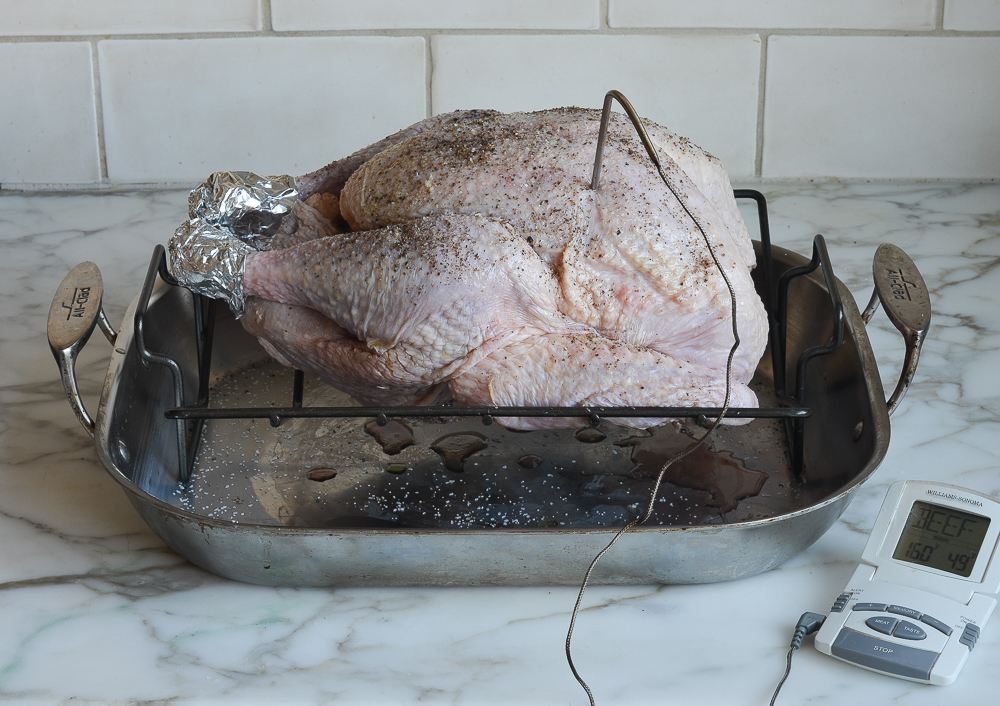
Place the turkey in the oven and roast, without basting, until the thermometer reaches 160°F, 1 to 1-1/2 hours. Halfway through roasting time, rotate the pan in the oven to assure even cooking and browning. (If at any point your kitchen gets unbearably smoky or the fat is spitting, pour a cup of tepid water in the roasting pan. Just keep in mind that liquid will create steam, which prevents the skin from getting as crispy.) Remove the pan from the oven.
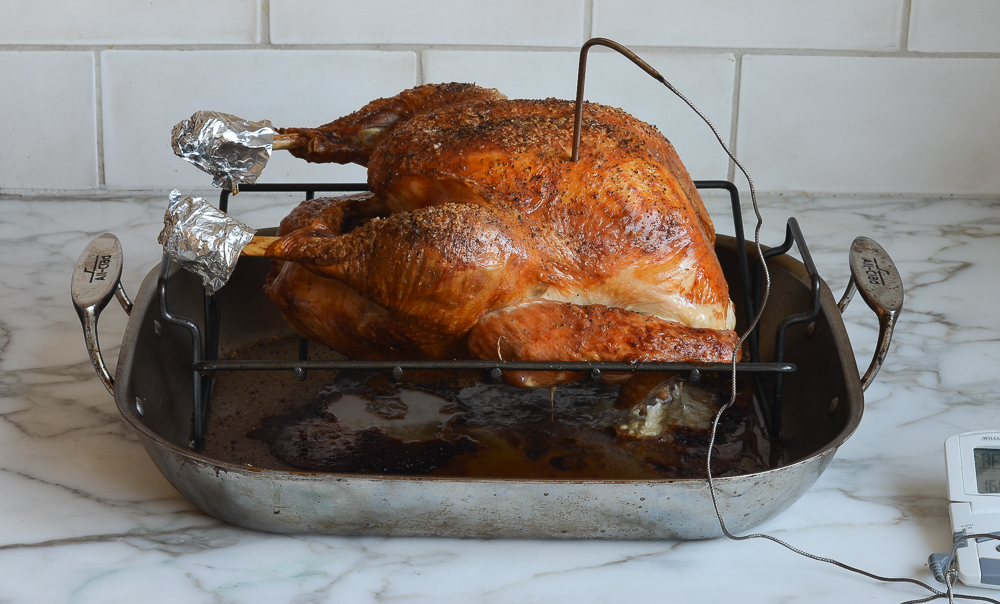 Using oven mitts that you don’t mind getting dirty, carefully tilt the turkey so that the juices from the cavity run into the roasting pan. Transfer the turkey to a platter or cutting board (do not clean the roasting pan), tent the turkey with foil, and let it rest for 20 to 30 minutes. This will allow the internal temperature to reach at least 165°F (the USDA safe-cooking temperature for turkey) and the juices to settle.
Using oven mitts that you don’t mind getting dirty, carefully tilt the turkey so that the juices from the cavity run into the roasting pan. Transfer the turkey to a platter or cutting board (do not clean the roasting pan), tent the turkey with foil, and let it rest for 20 to 30 minutes. This will allow the internal temperature to reach at least 165°F (the USDA safe-cooking temperature for turkey) and the juices to settle.
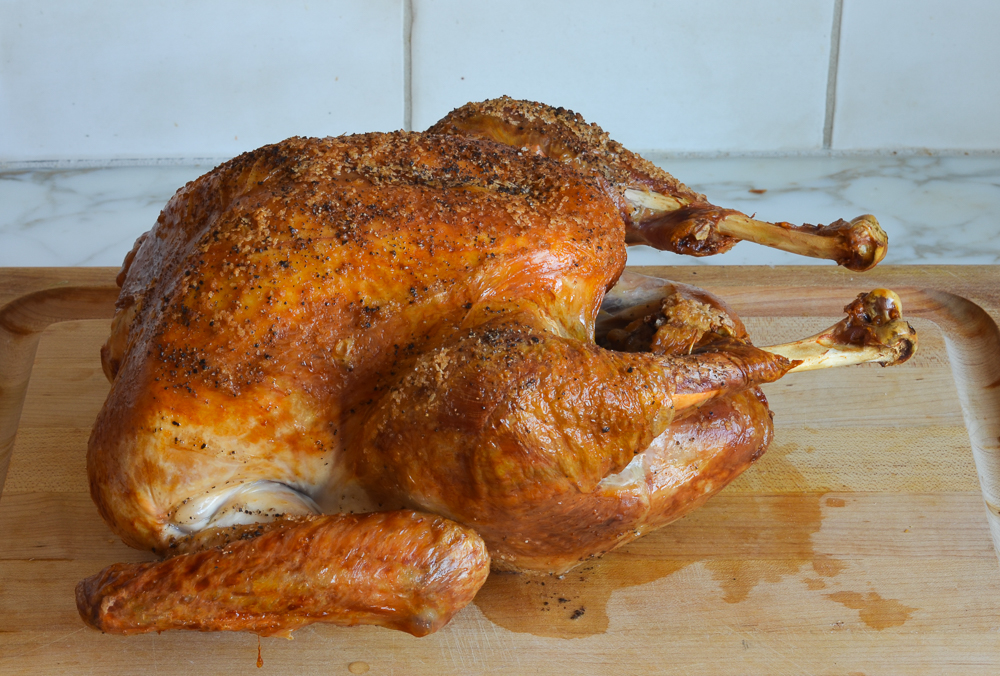
How To Make Gravy
While the turkey rests, make the gravy: Place the roasting pan over a burner on your stove. (Be careful handling the pan, as the handles will be hot.) Skim away any excess fat or solids that have accumulated in the pan.
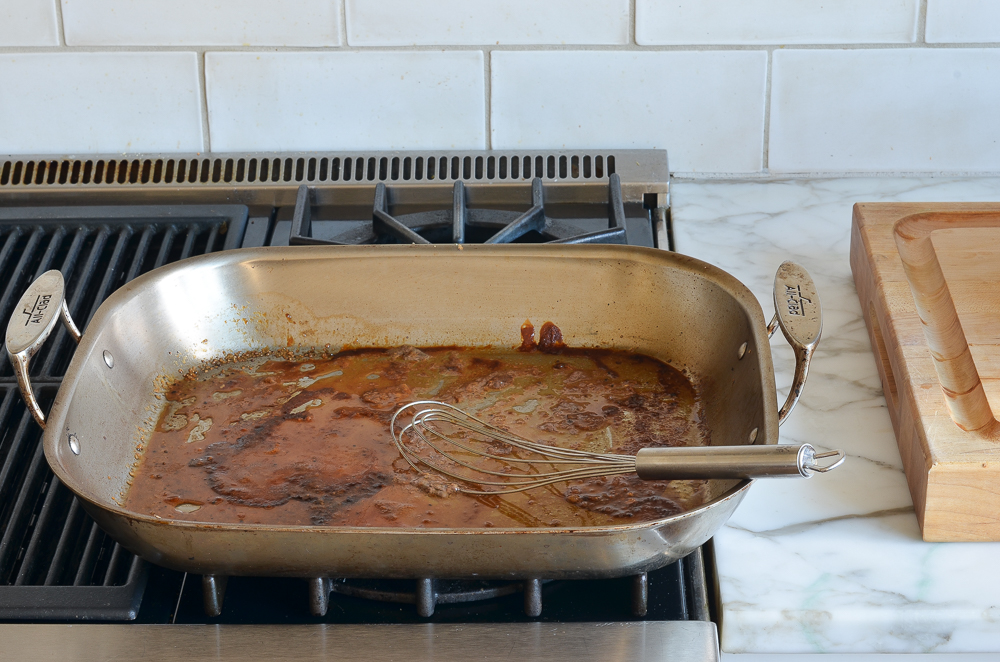
Add the broth and cook over medium heat, scraping the bottom of the pan with a whisk or wooden spoon to loosen any brown bits, until simmering. Turn off the heat and set aside.
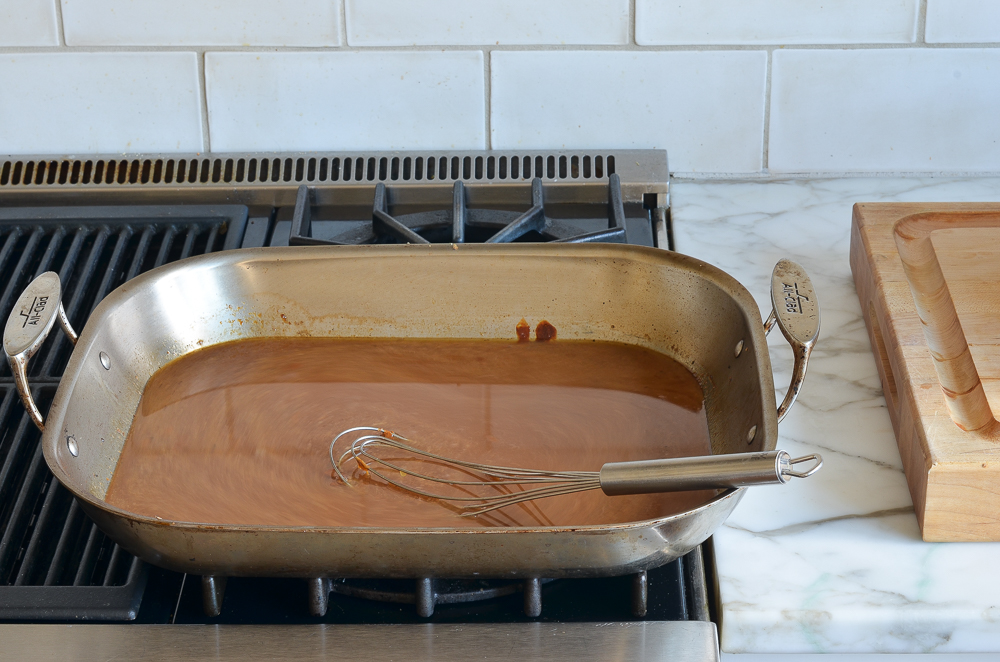
In a medium saucepan, melt the butter over medium-low heat.

Add the onions.
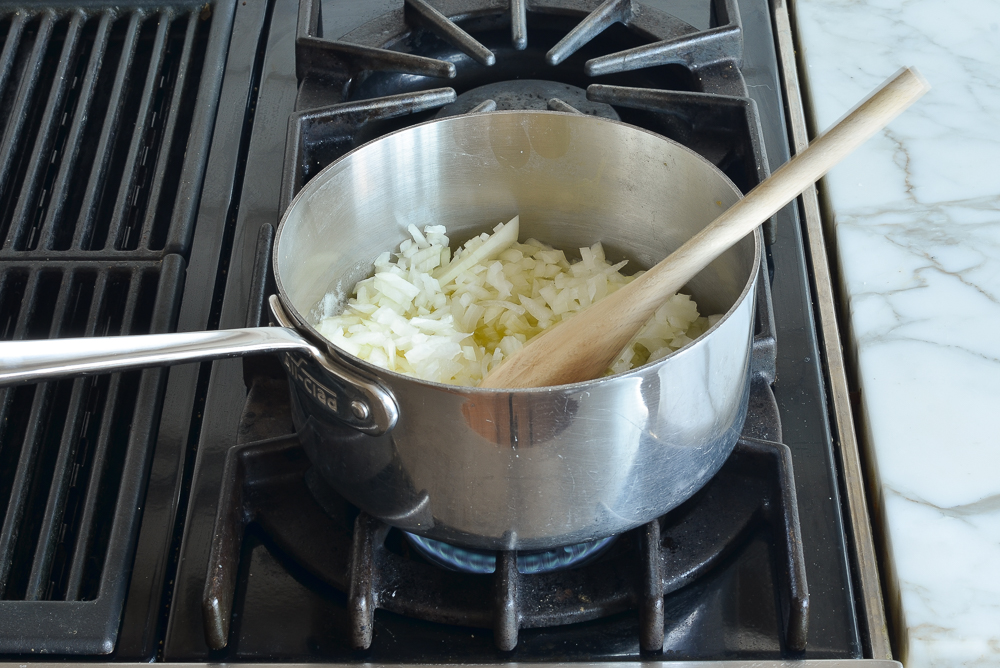
Cook until very soft and translucent, about 15 minutes. Do not brown.
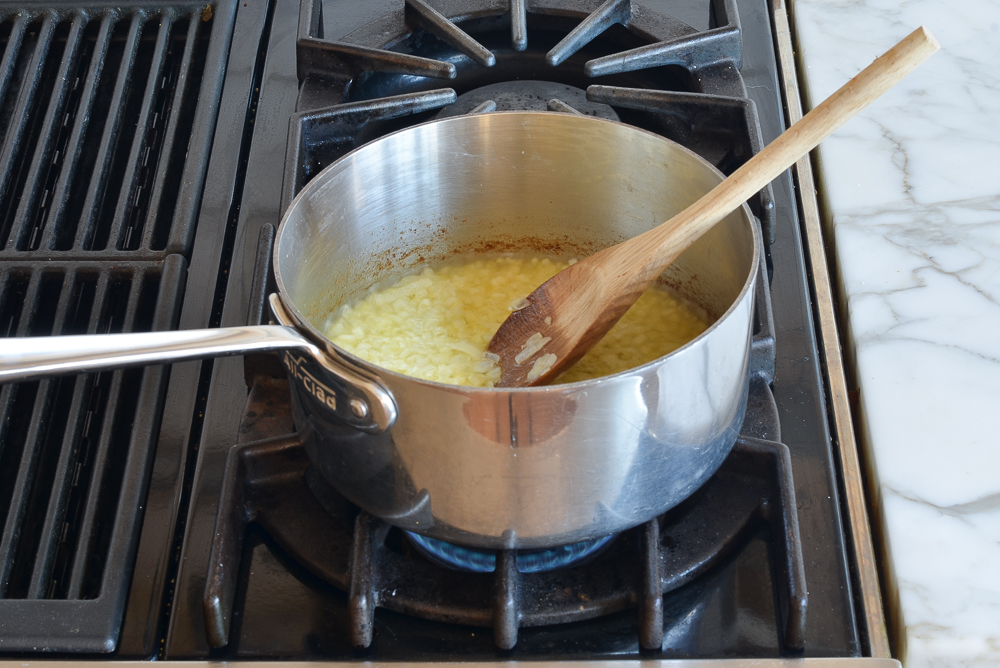
Add the flour.
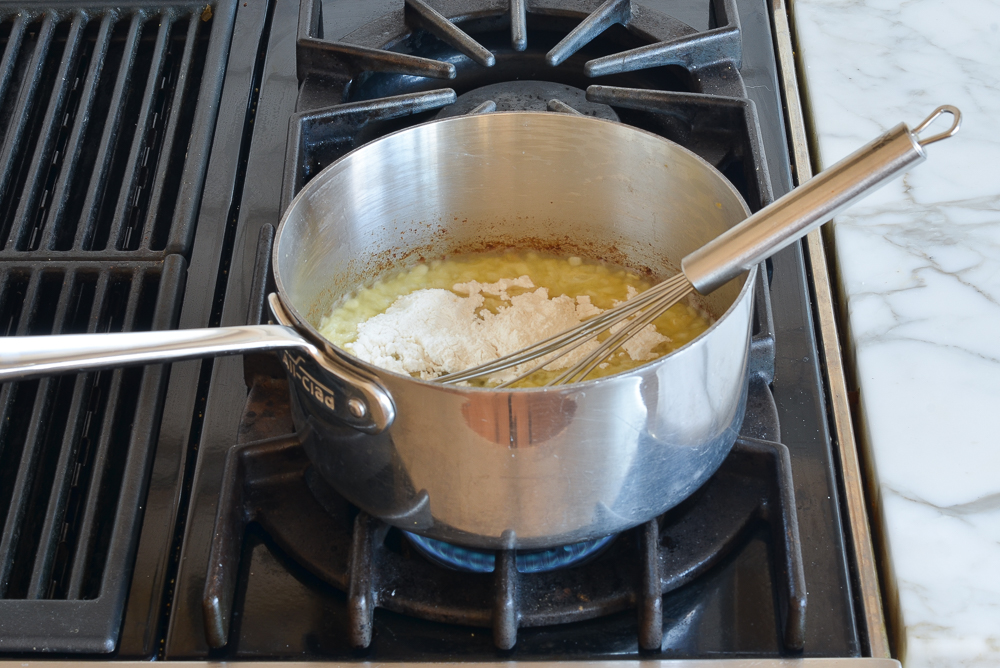
Whisk and cook for 2 to 3 minutes, stirring occasionally.
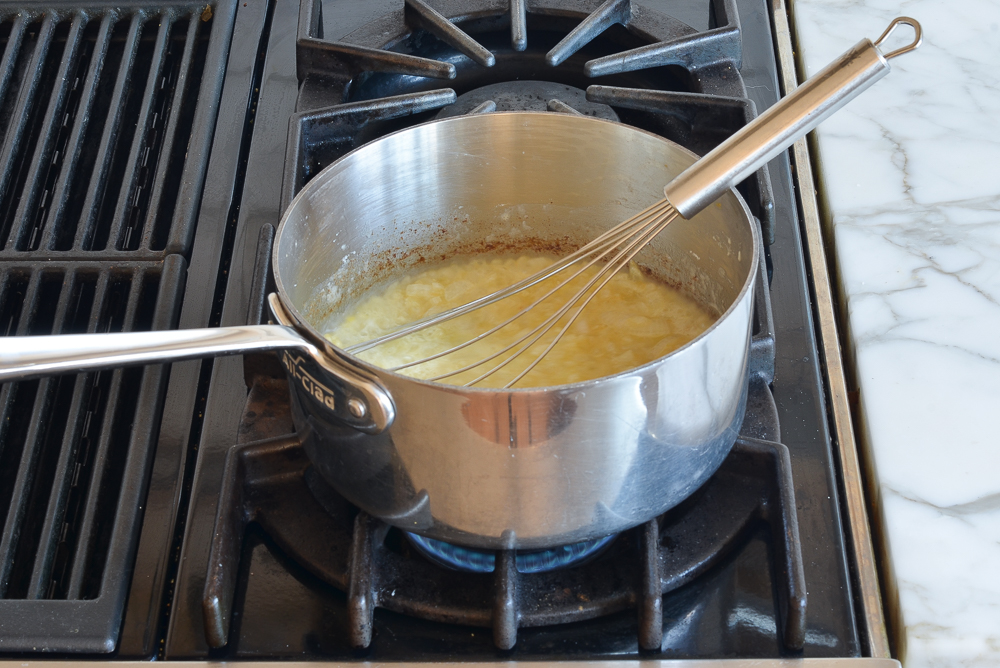
Whisk in the turkey dripping-chicken broth mixture and Cognac and cook, uncovered, stirring occasionally, for about 5 minutes until thickened.
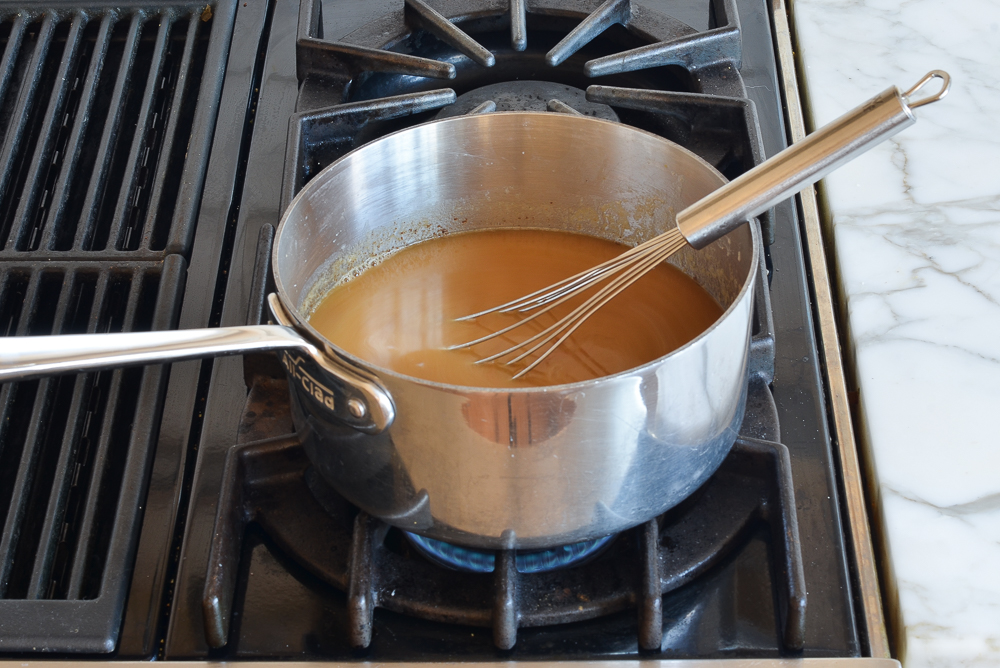
Stir in the cream (if using) and chopped herbs. Taste and adjust seasoning with salt and pepper, if necessary.
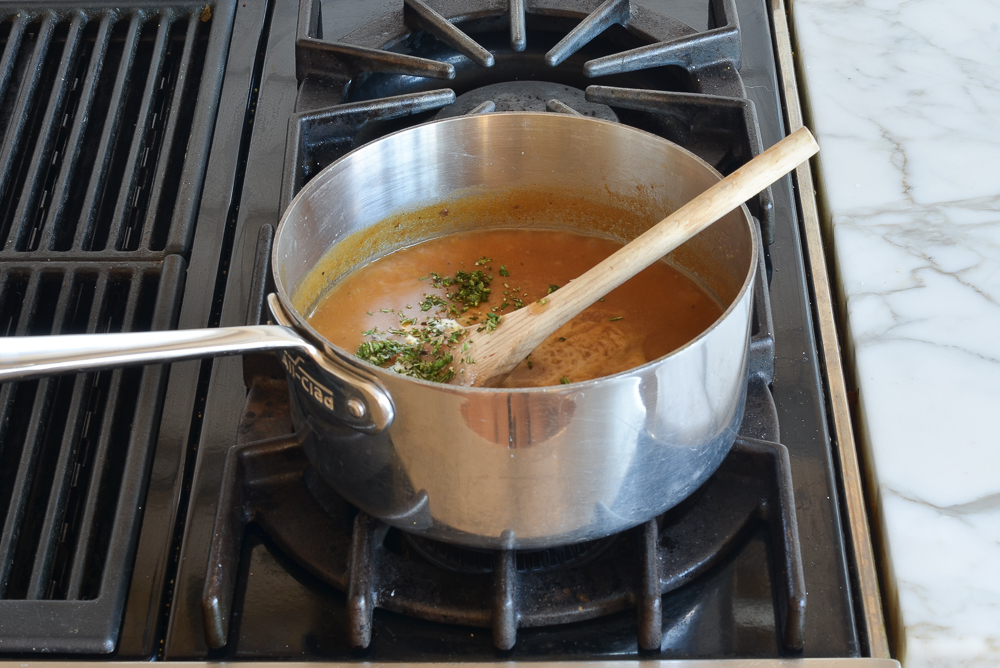
Transfer to a gravy bowl. Carve the turkey and serve with the gravy on the side.
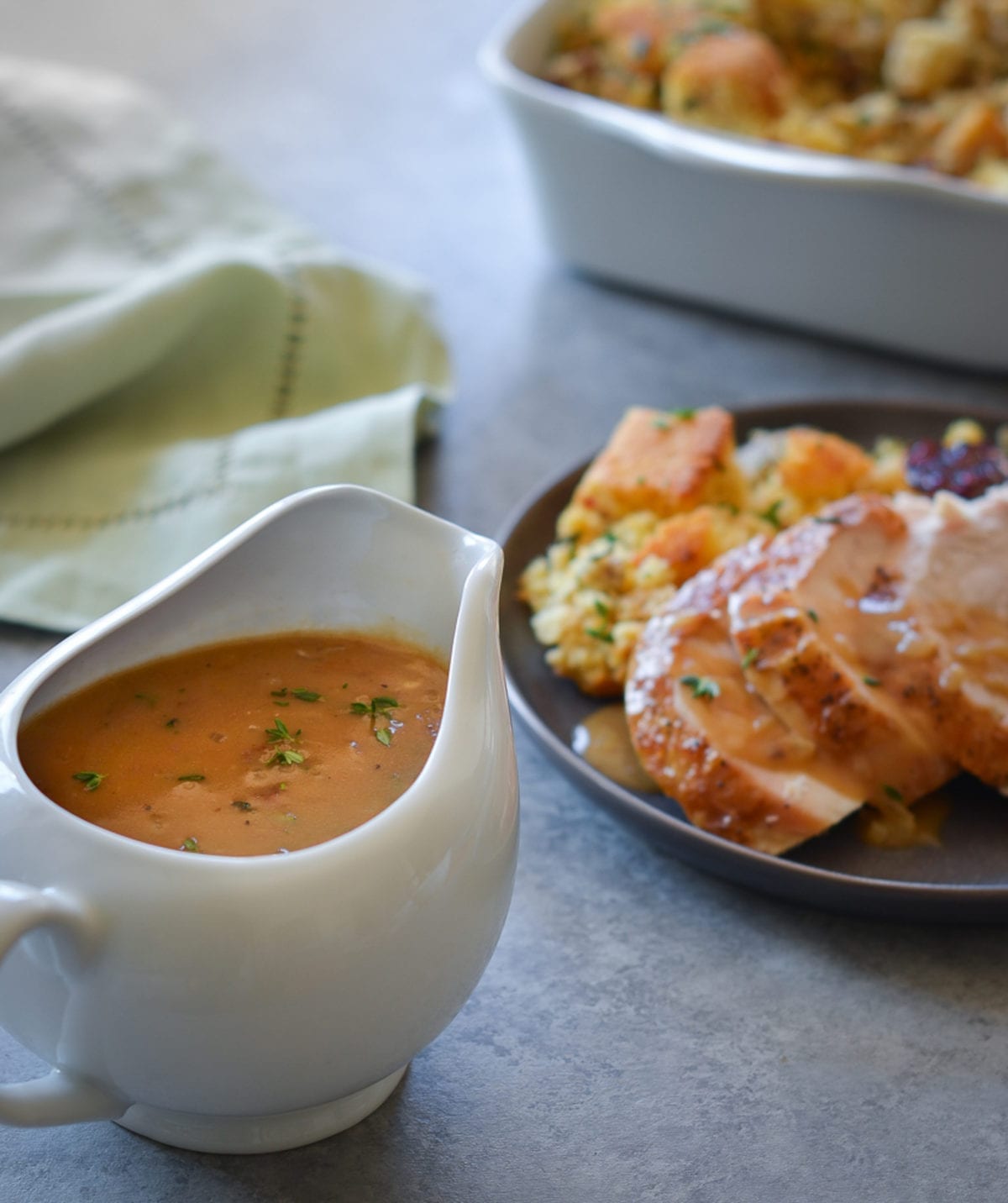
You may also like
- Rolled Turkey Breast with Sausage and Herb Stuffing
- Fresh Orange Cranberry Sauce
- Brussels Sprouts Gratin
Easy High-Heat Roast Turkey With Gravy
Ideal for turkeys under 14 pounds, the high-heat method guarantees a juicy and crisp-skinned turkey.
Ingredients
- 1 fresh turkey (11 to 14 lbs)
- 1 tablespoon olive oil
- 1½ tablespoons kosher salt
- 1 teaspoon freshly ground black pepper
- 2¼ cups chicken broth
- 8 tablespoons (1 stick) unsalted butter
- 1½ cups finely chopped yellow onion, from 1 large yellow onion
- ¼ cup all-purpose flour
- 2 tablespoons Cognac or brandy
- 1 tablespoon heavy cream, optional
- 1 tablespoon chopped fresh herbs (such as thyme, sage, rosemary, or parsley)
You Will Need:
- 13 x 16 x 3-inch heavy stainless-steel roasting pan
- V-shaped roasting rack
- Leave-in digital meat thermometer, like this one
Instructions
- Before cooking, be sure that your oven is VERY clean to prevent smoking. Preheat the oven to 450°F and set an oven rack in the lowest position.
- Remove and discard truss that holds turkey legs together. Trim off and discard any excess fat in the neck or body cavity. Remove giblets and neck; discard or save for stock.
- Rinse the turkey inside and out with warm water. Pat dry with paper towels. Place a V-shaped rack in a 13 x 16 x 3-inch heavy stainless-steel roasting pan. (Do not use a dark roasting pan or a disposable aluminum pan.) Rub the turkey skin all over with the olive oil and sprinkle with the salt and pepper. Set the bird breast-side-up on the rack. Pull the wings away from the body, then firmly twist them to push the wing tips under the bird. Using aluminum foil, form caps over the tips of the end of each drumstick. (Do not tie the legs together, add stuffing, or close the body cavity.) Insert a digital leave-in meat thermometer near the center of the breast through the thickest part until the tip touches the bone.
- Turn on your exhaust fan and crack a kitchen window. Place the turkey in the oven and roast, without basting, until the thermometer reaches 160°F, 1 to 1½ hours. If your oven has hot spots, rotate the pan halfway through cooking to assure even browning. (If at any point your kitchen gets unbearably smoky or the fat is spitting, pour a cup of tepid water in the roasting pan. Just keep in mind that the liquid will create steam in the oven, so the skin won't be quite as crispy.)
- Remove the pan from the oven. Using clean oven mitts (that you don't mind getting dirty), carefully tilt the turkey so that the juices from the cavity run into the roasting pan. Transfer the turkey to a platter or cutting board (do not clean the roasting pan), tent the turkey with foil, and let it rest for 20 to 30 minutes. This will allow the internal temperature to reach at least 165°F (the USDA safe-cooking temperature for turkey) and the juices to settle.
- While the turkey rests, make the gravy: Place the roasting pan on a burner on your stove. (Be very careful handling the pan; it's easy to forget that it's hot.) Skim away any excess fat or solids that have accumulated in the pan. Add the broth and cook over medium heat, scraping the bottom of the pan with a whisk or wooden spoon to loosen any brown bits, until simmering. Turn off the heat and set aside.
- In a medium sauce pan, melt the butter over medium-low heat. Add the onions and cook until very soft and translucent, about 15 minutes. Do not brown. Whisk in the flour and cook for 2 to 3 minutes, stirring occasionally. Whisk in the turkey dripping-chicken broth mixture and Cognac and cook, uncovered, stirring occasionally, for about 5 minutes or until thickened. Stir in the cream (if using) and chopped herbs. Taste and adjust seasoning with salt and pepper, if necessary. Transfer to a gravy bowl.
- Carve the turkey and serve with the gravy on the side.
- Note: Nutritional information is based on an 11-pound turkey with 10 servings.
- Make-Ahead Instructions: If you don't mind losing the crispy skin, the turkey can be roasted and carved ahead of time. Pour a thin layer of the gravy into an ovenproof serving platter. Arrange the carved turkey nicely on top of the gravy; cover tightly with plastic wrap and refrigerate for up to two days. Refrigerate the remaining gravy in a separate container. To reheat: remove the plastic wrap and cover the platter with aluminum foil. Place in a 325°F-oven for 20 to 30 minutes, until the turkey is hot. Reheat the gravy in the microwave or on the stovetop.
Pair with
Nutrition Information
Powered by ![]()
- Per serving (8 servings)
- Calories: 859
- Fat: 39 g
- Saturated fat: 13 g
- Carbohydrates: 7 g
- Sugar: 2 g
- Fiber: 1 g
- Protein: 110 g
- Sodium: 1,386 mg
- Cholesterol: 385 mg
This website is written and produced for informational purposes only. I am not a certified nutritionist and the nutritional data on this site has not been evaluated or approved by a nutritionist or the Food and Drug Administration. Nutritional information is offered as a courtesy and should not be construed as a guarantee. The data is calculated through an online nutritional calculator, Edamam.com. Although I do my best to provide accurate nutritional information, these figures should be considered estimates only. Varying factors such as product types or brands purchased, natural fluctuations in fresh produce, and the way ingredients are processed change the effective nutritional information in any given recipe. Furthermore, different online calculators provide different results depending on their own nutrition fact sources and algorithms. To obtain the most accurate nutritional information in a given recipe, you should calculate the nutritional information with the actual ingredients used in your recipe, using your preferred nutrition calculator.

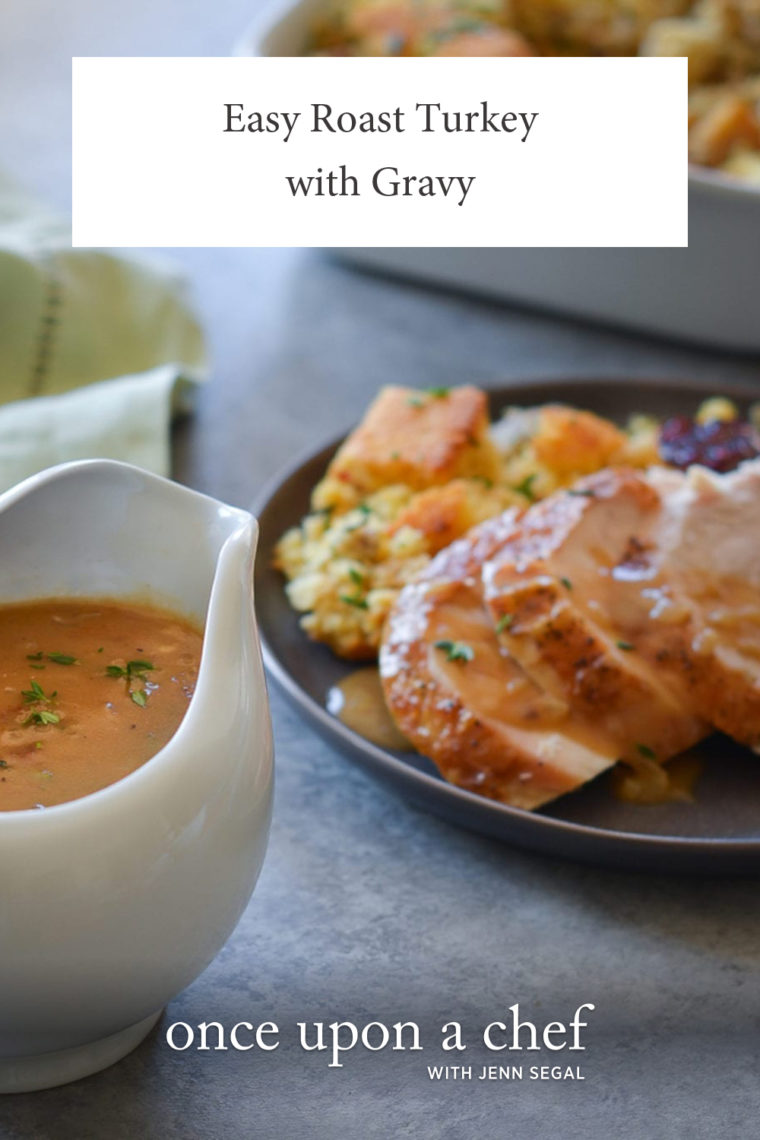
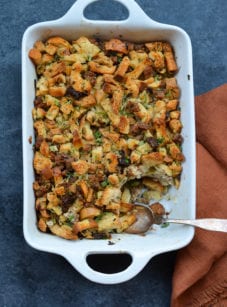
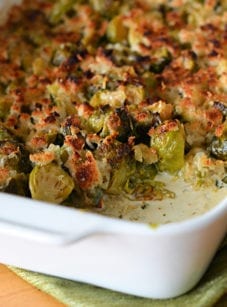
I have an old dark roasting pan. Just curious why you don’t recommend using it. Thanks!
Hi Danielle, What type of pan is it? Is it heavy? If it’s a good-quality heavy pan, it should be fine (it’s those dark speckled pans that a lot of people have that cause problems).
It is the dark speckled pan unfortunately. My other pans aren’t large enough to hold the turkey without some of the turkey hanging out of the pan.
Jenn, I too have a dark roasting pan. its similar to this one from Crate and Barrel:
All-Clad ® HA1 Hard Anodized Nonstick Roaster with Rack
Is this ok to use?
Yes, that looks like it should be fine. Enjoy!
If I want to make the gravy gluten-free, would a 1 to 1 gluten-free flour be better or cornstarch?
Hi Sandy, I’d go with the gluten-free flour. Hope you enjoy!
Hi Jenn,
So, I’ve heard of the Safeway method from many years ago but just wasn’t too confident in trying it. However, when I saw that You did it, I was more than happy to give it a shot. I made a 13# turkey yesterday (day after Thanksgiving) and it was beautiful not to mention so moist! It only took an hour an half and such a beautiful golden color which I’ve never been able to achieve with the traditional method of roasting. Thank you so much! Will definitely be making my turkey every year using your recipe.
can i use this method in a bbq? really afraid smoke will ruin the gathering. thanks
Hi Sam, I’ve never cooked a whole turkey on the grill so it’s hard to say for sure but I’d be concerned that the skin would burn before the turkey was cooked through. That said, here is a recipe for a grilled turkey if you want to take a peek.
Can you use this same recipe for a turkey or turkey breast that has been salted and refrigerated the night before? Or do you only recommend salting before baking?
I think that should be fine, Alycia (but only salt it once). 🙂
Thank you for all your recipes you share!
At what temp are you putting the turkey in the oven to “roast”
Happy holidays!
My pleasure, Lesa! The oven should be set to 450°F/230°C. 🙂
Hi there,
Can I inject the turkey with the Tony Chachere’s Injectable Butter Marinade, 17 fl oz seasoning and then use your high heat roasting method?—I’m afraid of the simple salt/pepper seasoning not adding enough flavor to mask an otherwise plain tasting/smelling turkey.
appreciate your input…
Hi Joojoo, I’ve never used anything like that, but I think it should work. 🙂
What can I substitute for the Cognac or brandy? Or should I just skip it?
Sure, Dottie, Brandy would be fine here. Enjoy!
I guess I wasn’t clear in my question. We don’t keep Cognac or brandy in the house, so is there a substitute you can suggest? Or can I just skip the 2 TB? Love your recipes. You are my go-to Chef!
Oh sorry Dottie – I misread your question! Yes, it’s fine to omit it – it won’t have a significant impact on the taste. (And glad you like the recipes 💗!)
I have a fresh, 16 pound turkey. You said that this recipe works best for turkeys under 14 pounds. Is there another recipe you would recommend for my larger turkey?
I think you could get away with a 16-lb turkey here, Kristiana; just reduce the heat to 425°F.
I’m thinking of making this recipe this year. My oven has convection roast, as well as the usual “bake”…is this a better setting?
I get your emails.
I create and test all my recipes using the regular “bake” setting so I’d go that route. If you’d prefer to use the convection setting, reduce the temperature by 25°F.
Hi Jenn! Love your recipes! Question on rinsing the turkey before cooking. It has been recently advised against this for sanitary reasons in one’s sink etc. Do you still advise doing so? Thanks for your thoughts.
Hi Janis, I still recommend rinsing the turkey if you’re comfortable. Just make sure you sanitize the sink and surrounding counter after doing it. Hope that helps!
Hi Jenn… I only have a dark roasting pan, would this recipe not work? Thank you!
Hi Stephanie, What type of pan is it? Is it heavy? If it’s a good quality heavy pan, it should be fine (it’s those dark speckled pans that a lot of people use that causes problems).
Hi Jenn:
Will be roasting a 24 lb turkey on Saturday. Do I double the cooking time as I don’t have a thermometer?
Also, you said not to stuff it. I’ve roasted turkeys before with stuffing, starting at 450 for 20 minutes and then turning heat to 350. Flip the bird half way through and repeat. But with 24 lb turkey it will difficult to flip so thought I’d try this method.
Any thoughts?
Hi Connie, This method works best for smaller turkeys because of the smoke issue but it’s doable with a bigger turkey if your oven is VERY, VERY clean and you use the right type of roasting pan. Also, be sure that no parts of the bird extend beyond the rim of the pan. (If any parts extend beyond the pan, the drippings will cause a LOT of smoke.) And if the turkey starts to get too dark on top toward the end, just cover it with foil. I’d guesstimate the cook time for a 24-lb turkey would be about 2 1/2 hours (but your best bet is to rely on a meat thermometer – you’ll remove the turkey from the oven when the temperature reaches 160°F). Hope that helps and please let me know how it turns out!